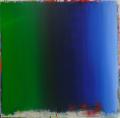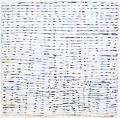Claude Bouyeure, 1992
____________________________
To write down painting
Marie-Cecile Aptel glues, unglues, tears off or places paper and especially tarlatan on canvas.
Her figures appear in a state of suspension. One notices in this artist a particu¬lar liking for fluidity.
Two years ago she used blue-grays, ochres; today, the green-stained tarlatan gives her spaces
a singular quality of silence, vibrations, tensions. And if color is not the goal of the painting,
it presents itself for what it is: a succession of whisperings on the surface.
Painting is not just a network of interlaced signs the length of the painting but a
surface as sensitive as it is deep and bearing the traces of different moments and ages.
What is first sought — so it seems, but the word is too materialistic — is a certain idea of efflorescence. However, efflorescence here is not only without a support (nothing, to the letter, blooms) but also and especially without a background: the motif does not stand out against a vague nothingness, it is the entire painting itself that is wrapped up in it. It is as if this efflorescence — which we first believed was immediate — is at the very limit of its concept.
For example, the law of being ascentional figurations, animated by a soaring movement, as is customary in all plant mythology; Aptel's figures neither rise, nor float. They have the firmness of position (in spite of their highly delicate animation) of objects grasped by a sort of levitation "holding them" in space without any obstacles, because being spaces themselves, they in no way have to conquer it or to utilize it. Here one can see the idea of a form, an efforescence, germinate, searching for its limits and accepting to destroy its natural attributes.
Aptel, contrary to so many contemporary painters, reveals her brushstrokes. She does not ask the spectator to see, to think, to savour the product, but to look again, to identify and — if one may say so — to "take delight" in the move¬ment coming from there. For as long as humanity has written by hand, the trajectory of the hand and not the visual perception of its work has been the fundamental act through which the letters were defined, studied, classified: this regulated act is what is called in paleography the ductus: the hand leads the trace from top to bottom, left to right, in turning, emphasizing, interrupting itself, etc... Of course, it is in ideographic writing that the ductus is most important. Rigorously coded, it allows the classification of characters according to the number, the direction of the brushstrokes. It creates the possibility of a dictionary for a writing without an alphabet. In Aptel's work the ductus reigns. Not its rules, but its games, its fantasies, its explorations, its laziness, its caresses. It is in short a writing of which only the slants, the traits, the cursiveness, the lines remain. Aptel's writing unfolds with finesse, leaning like grasses, making time, the quivering of time, visible.
One seems to recognize familiar things through these traces, these contours, animals, landscapes. They are only pretexts. Because little by little before our eyes the back-ground absorbs the motif. Thus begins a wonderful voyage full of incidents through the pictorial space. This space give life to everything that in painting can live only through the life of painting.
Penetrating the space of the eye, the fluidity, the transparencies install in it the very reality of wandering.
The eyes of all lovers of wanderings shall be blue, these voyagers for whom blue, gray-blue, ochre and green live in an erotic or spiritual manner in violet. In violet mist. This thematic of metamorphosis, of effusion, of transportation, of liquidity. Another step and the figure dissolves in the expanse. Its freedom becomes that of a cloud. Cloud which elevates with its impalpable breath the most hidden or the most inert realities. Transported into the field of this space, the motif takes the form of a questioning, of directed silence, of paleness dreamt like the lightness of the substance of the world.
Claude Bouyeure, critique, in Cimaise N°217, avril-mai 1992






